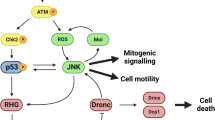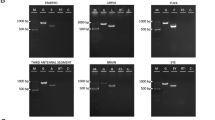Abstract
Results from various experiments suggest that the cell surface has an important role in development1. However, there is relatively little information on the specific surface molecules involved in developmental processes. In an effort to characterize cell-surface components that may be involved in Drosophila development, we have been making monoclonal antibodies against D. melanoyaster imaginal disks2. The holometabolous insects are unusual in that scattered among the larval tissues are groups of undifferentiated imaginal cells which, during metamorphosis, will form most of the adult insect3,4. The imaginal disks, which we use as an immunogen, are hollow sacs of cells; each disk will form a specific part of the adult cuticle. Other imaginal cells are found as nests or rings in various larval organs. We describe here results indicating that one of the clones we have isolated, DA.1B6, makes an antibody against an antigen which, in larvae, is generally restricted to the undifferentiated sheets of imaginal epithelial cells. This and other results indicate that the antigen is specific for the diploid epithelia in Drosophila.
This is a preview of subscription content, access via your institution
Access options
Subscribe to this journal
Receive 51 print issues and online access
$199.00 per year
only $3.90 per issue
Buy this article
- Purchase on Springer Link
- Instant access to full article PDF
Prices may be subject to local taxes which are calculated during checkout
Similar content being viewed by others
References
Karkinen-Jääskeläinen, M., Saxén, L. & Weiss, L., (eds) Cell Interactions in Differentiation (Academic, London, 1977).
Wilcox, M., Brower, D. & Smith, R. J. in Development and Behaviour of D. melanogaster (eds Siddiqi, O., Hall, L. & Babu, P.) (Plenum, New York, 1980).
Bodenstein, D. in Biology of Drosophila (ed. Demerec, M.) 275–337 (Hafner, New York, 1965).
Anderson, D. T. in Developmental Systems: Insects Vol. 1 (eds Counce, S. J. & Waddington, C. H.) 165–242 (Academic, London, 1972).
Köhler, G., Howe, S. G. & Milstein, C. Eur. J. Immun. 6, 292–295 (1976).
Galfré, G., Howe, S. C., Milstein, C., Butcher, G. W. & Howard, J. C. Nature 266, 550–552 (1977).
Cotton, R. G. H., Secher, D. S. & Milstein, C. Eur. J. Immun. 3, 135–140 (1973).
Poodry, C. A. & Schneiderman, H. A. Wilh. Roux' Arch. 166, 1–44 (1970).
Reed, C. T., Murphy, D. & Fristrom, D. Wilh. Roux' Arch. 178, 285–302 (1975).
Mahowald, A. P., Caulton, J. H., Edwards, M. K. & Floyd, A. D. Expl Cell Res. 118, 404–410 (1979).
King, R. C. Ovarian Development in Drosophila melanogaster (Academic, New York, 1970).
Mahowald, A. P. in Developmental Systems: Insects Vol. 1 (eds Counce, S. J. & Waddington, C. H.) 1–47 (Academic, London, 1972).
Hardy, R. W., Tokuyasu, K. T., Lindsley, D. L. & Garavito, M. J. ultrastruct. Res. 69, 180–190 (1979).
Bownes, M. J. Embryol. exp. Morph. 33, 709–801 (1975).
Garcia-Bellido, A., Ripoll, P. & Morata, G. Devl Biol. 48, 132–147 (1976).
Crick, F. H. C. & Lawrence, P. A. Science 189, 340–347 (1975).
Gehring, W. J. in The Genetics and Biology of Drosophila Vol. 2C (eds Ashburner, M. & Wright, T. R. F.) 511–554 (Academic, London, 1978).
Author information
Authors and Affiliations
Rights and permissions
About this article
Cite this article
Brower, D., Smith, R. & Wilcox, M. A monoclonal antibody specific for diploid epithelial cells in Drosophila. Nature 285, 403–405 (1980). https://doi.org/10.1038/285403a0
Received:
Accepted:
Issue Date:
DOI: https://doi.org/10.1038/285403a0
This article is cited by
-
The Drosophila gene torso encodes a putative receptor tyrosine kinase
Nature (1989)
-
Tissue-specific schedule of selective replication in Drosophila nasutoides
Roux's Archives of Developmental Biology (1986)
-
Positional cell surface antigens in an insect appendage
Wilhelm Roux's Archives of Developmental Biology (1982)
Comments
By submitting a comment you agree to abide by our Terms and Community Guidelines. If you find something abusive or that does not comply with our terms or guidelines please flag it as inappropriate.



